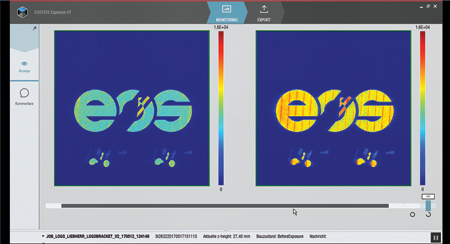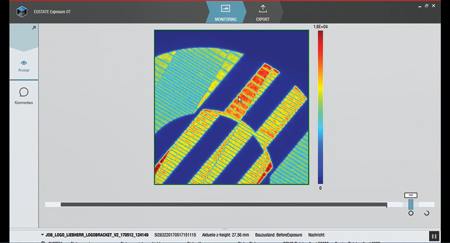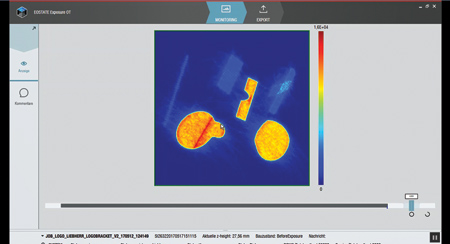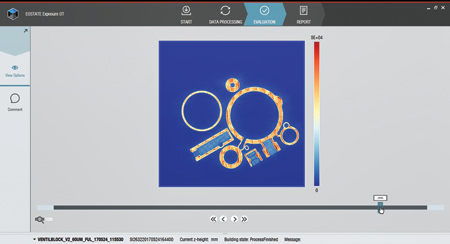
Live view of EOSTATE Exposure OT during the build process

The enlargement shows different exposure strategies.

For analysis purposes, the software provides enlarged details of the built part.

Users can seamlessly scroll within seconds through thousands of layers and understand quality relevant data, for example the heat distribution during the build process.
EOS is expanding its EOSTATE monitoring suite to include an additional tool. "EOSTATE Exposure OT, the first commercial system for optical tomography worldwide, now provides real-time, camera-based monitoring of the additive, metal-based build process, based on the EOS M 290 system," said a company spokesperson. The solution fully maps each part throughout the build process, layer by layer, regardless of its geometry and size.
Dr. Tobias Abeln, Chief Technical Officer (CTO), explained: "With EOSTATE Exposure, we are offering companies an even more comprehensive process monitoring and quality assurance. As such, we are helping customers meet the stringent inspection requirements for each component, particularly in sectors such as aerospace." He continued, "Quality assurance is essential in large-scale manufacturing where reproducible component qualities are of prime significance. Costs for quality assurance are significantly reduced as the monitoring process occurs early on at the build process stage. This has a positive impact on costs per part as well."
Partnership with MTU
The solution was developed in close collaboration with EOS strategic partner MTU Aero Engines. EOSTATE Exposure OT enables the partner to reduce costs for downstream, non-destructive examination in technical computer tomography (CT), because potentially defective parts can be rejected at an earlier stage. At MTU Aero Engines, EOSTATE Exposure OT was primarily developed for series manufacturing purposes, where it has been in use for several months and proven its efficiency. The two other pilot customers, Liebherr and IPC, will also continue to use the system after the pilot phase and integrate it in their manufacturing processes.
"At MTU Aero Engines we recognized the potential of additive manufacturing (AM) early on. However, until now we did not have the experience and the volume of data needed to sufficiently evaluate the quality of the parts and transfer the technology to large-scale manufacturing. We are confident that we will be able to do so with EOSTATE Exposure OT," said Dr. Jürgen Kraus, Senior Consultant Additive Manufacturing at MTU. He continued, "The new OT solution has meanwhile proven itself in practical tests and we are very happy that other customers will now be able to benefit from it, too. It provides genuine added value."
Alexander Altmann, Lead Engineer Additive Manufacturing/TRPI Research & Technology at Liebherr, said, "We are now using EOSTATE Exposure OT and EOSTATE MeltPool from EOS and expect both technologies to give us a profound understanding of the phenomena relevant for quality when additively producing titanium parts." He continued, "In the medium to long term, we will be looking to produce highly complex flight control system components using AM. Here, real-time process monitoring as well is key to create an economically viable process chain. Widely used non-destructive examination processes such as CT are quite elaborate and expensive for manufacturing valve blocks."
Optical Tomography: How the Process Works
With optical tomography (OT), the system deploys a high-resolution camera to seamlessly monitor the exposure process. A highly dynamic industrial camera records the complete building platform at high frequency in the near-infrared range throughout the entire AM process, thereby providing detailed data on the melting behavior of the material across the entire build space.
Based on the data captured, the melting behavior of steel, aluminum, titanium and a variety of alloys involved in the additive build process can be analyzed and monitored in great detail using special software. If certain results deviate from a normal range, which can be individually defined by means of parameters, these areas are marked. The growing volume of data makes it possible to determine the impact of these indicators on the quality of the manufactured parts with ever greater precision.
EOSTATE Exposure OT is a self-learning system that becomes increasingly intelligent the more data it is fed. The more precisely users become familiar with the specific parameters of their components, the better they can assess the quality and density of the parts they are manufacturing. The ultimate aim is to recognize possible sources of defects during the building process and reject any defective parts.
For more information contact:
EOS of North America, Inc.
28970 Cabot Drive, Suite 700
Novi, MI 48377-2978
248-306-0143
info@eos-na.com
www.eos.info